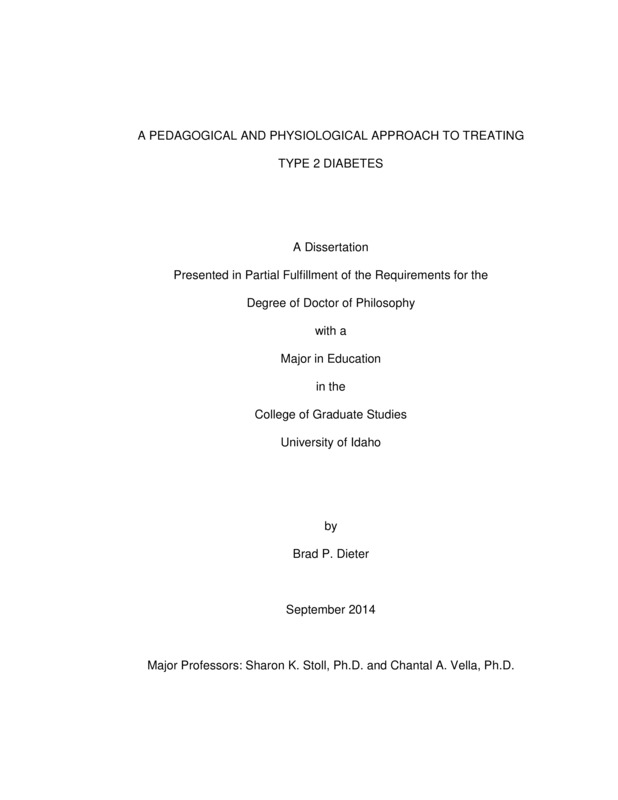A PEDAGOGICAL AND PHYSIOLOGICAL APPROACH TO TREATING TYPE II DIABETES
Dieter, Brad Pendleton. (2014). A PEDAGOGICAL AND PHYSIOLOGICAL APPROACH TO TREATING TYPE II DIABETES. Theses and Dissertations Collection, University of Idaho Library Digital Collections. https://www.lib.uidaho.edu/digital/etd/items/dieter_idaho_0089e_10408.html
- Title:
- A PEDAGOGICAL AND PHYSIOLOGICAL APPROACH TO TREATING TYPE II DIABETES
- Author:
- Dieter, Brad Pendleton
- Date:
- 2014
- Keywords:
- Diabetes Education Exercise Nrf2 Reasoning
- Program:
- Movement & Leisure Sciences
- Subject Category:
- Physiology; Education; Molecular biology
- Abstract:
-
Background: Lack of exercise and sedentary behavior are primary risk factors for the development of type 2 diabetes mellitus (T2DM). Furthermore, physical activity (PA) and exercise are effective therapeutic tools for reducing diabetic complications and may reduce mortality rates. Despite this evidence, only 65% of adults and 47% of college students in the United States meet the suggested physical activity guidelines, indicating that human behavior plays a fundamental role in the increasing prevalence of T2DM. Human behaviors are formed through a reasoning process. Therefore, a reasoning-based approach may prove efficacious in improving PA. Furthermore, the mechanisms behind the beneficial effect of exercise on T2DM remain elusive. Oxidative stress plays a causal role in diabetic complications. The transcription factor, NF-E2-related factor 2 (Nrf2) protects against oxidative stress and exercise increases Nrf2 in healthy humans. Therefore, research regarding the effect of exercise on Nrf2 in T2DM is warranted. Purpose: The purpose of this dissertation was to conduct two separate lines of research to explore behavioral and physiological aspects of exercise and diabetes. Methods: College-aged individuals participated in an online higher-level reasoning based educational intervention designed to increase PA. Measures of PA and social-cognitive variables regarding PA were assessed pre and post intervention. For the physiology studies, normal and diabetic (db/db) mice underwent an acute exercise bout and western blotting and qPCR were utilized examine Nrf2 activity. We further explored the role of OGT and O-GlcNAcylation on Nrf2 signaling using an OGT knockdown mouse and conducted in vitro studies in cardiomyocytes. Results: The reasoning based intervention significantly increased the level of reasoning and leisure time PA amongst the experimental group. In our exercise study, we demonstrated that acute exercise increases Nrf2 protein content and mRNA expression Nrf2 transcription only in the normal mice. We also showed that protein O-GlcNAcylation is altered in the db/db mouse heart. Loss of the OGT enzyme resulted in drastic reduction in Catalase mRNA. Conversely, increasing O-GlcNAcylation in H9C2 cells augmented Nrf2 transcription. Lastly, we showed that Nrf2 is O-GlcNAcylated and in silico analysis identified Thr595 as a possible O-GlcNAcylation site near NLS and co-activation motif. Conclusions: These results suggest that improving reasoning regarding PA improves LTPA and cognitive domains associated with PA amongst college students. Our physiological data suggest that exercise-induced increases in the Nrf2 response is blunted in the db/db mouse and O-GlcNAc modification may play a role the Nrf2 signaling cascade.
- Description:
- doctoral, Ph.D., Movement & Leisure Sciences -- University of Idaho - College of Graduate Studies, 2014
- Major Professor:
- Stoll, Sharon K; Vella, Chantal A
- Committee:
- Barnes, Justin J; Williams, Chris W
- Defense Date:
- 2014
- Identifier:
- Dieter_idaho_0089E_10408
- Type:
- Text
- Format Original:
- Format:
- application/pdf
- Rights:
- In Copyright - Educational Use Permitted. For more information, please contact University of Idaho Library Special Collections and Archives Department at libspec@uidaho.edu.
- Standardized Rights:
- http://rightsstatements.org/vocab/InC-EDU/1.0/

